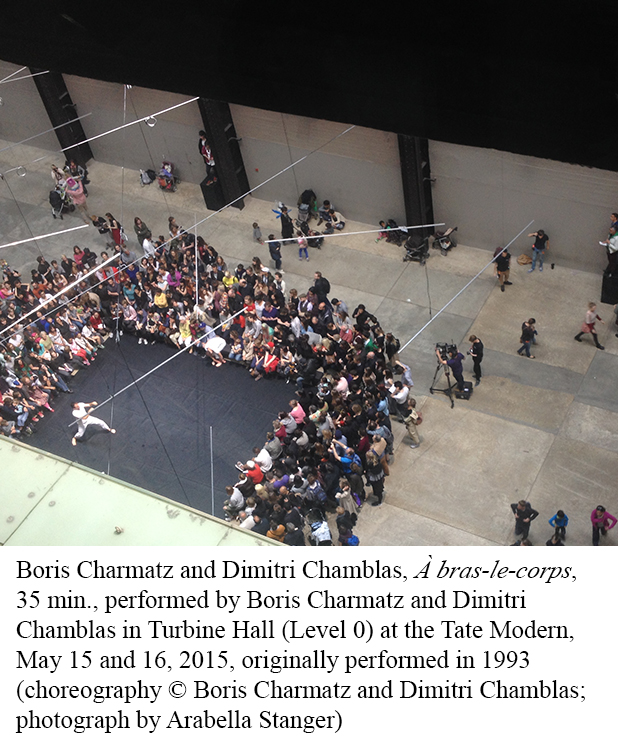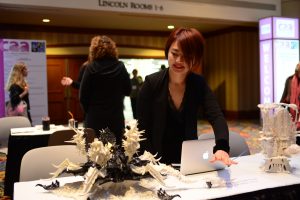CAA News Today
New in caa.reviews
posted by CAA — September 09, 2016
 Boris Charmatz’s If Tate Modern Was Musée de la Danse? (May 15–16, 2015) is the focus of a new multimedia review on the Scalar platform, If caa.reviews were performance.reviews. Organized by Juliet Bellow, the project includes an introduction by Bellow, and three reviews of the performances at the Tate Modern by Arabella Stanger, Nicole Zee, and Tamara Tomic-Vajagic. The review presents the complexities of Charmatz’s transformation of the Tate Modern into a museum of dance for two days and features an interactive map showing where the performances occurred in the Tate Modern, in addition to videos and still images. Charmatz’s project challenges conceptions of museums as institutional spaces and incorporates audience participation and “unauthorized” performances. This review is part of a new caa.reviews initiative to review time-based media works.
Boris Charmatz’s If Tate Modern Was Musée de la Danse? (May 15–16, 2015) is the focus of a new multimedia review on the Scalar platform, If caa.reviews were performance.reviews. Organized by Juliet Bellow, the project includes an introduction by Bellow, and three reviews of the performances at the Tate Modern by Arabella Stanger, Nicole Zee, and Tamara Tomic-Vajagic. The review presents the complexities of Charmatz’s transformation of the Tate Modern into a museum of dance for two days and features an interactive map showing where the performances occurred in the Tate Modern, in addition to videos and still images. Charmatz’s project challenges conceptions of museums as institutional spaces and incorporates audience participation and “unauthorized” performances. This review is part of a new caa.reviews initiative to review time-based media works.
caa.reviews publishes over 150 reviews each year. Founded in 1998, the site publishes timely scholarly and critical reviews of studies and projects in all areas and periods of art history, visual studies, and the fine arts, providing peer review for the disciplines served by the College Art Association. Publications and projects reviewed include books, articles, exhibitions, conferences, digital scholarship, and other works as appropriate. Read more reviews at caa.reviews.
A New Look for Your CAA Account
posted by CAA — September 09, 2016
September is a busy month for CAA and its members. Classes start again. Campuses buzz with activity. Registration opens for the 2017 Annual Conference in New York, February 15-18, 2017, and we will launch CAA Connect (stay tuned for that announcement). Before these announcements, we wanted to let you know we have updated and streamlined your CAA account experience.
Effective immediately, the web pages for your CAA Account will look and navigate a little differently. In addition to a more contemporary look, the pages are designed to work with devices of any screen size (smart phone, tablet, desktop/laptop) and use familiar web page techniques on smaller devices that you may see elsewhere.
Please take a moment to log in to your CAA Account and familiarize yourself with where to find content including:
- Contact information
- Membership status
- Member benefits with specific codes for redemption
- Payment receipts, printable as PDF files
- Communication preferences
You may log in using your user ID# or primary email address and your password. If you do not remember your password, you may reset it using your primary email address. If you have any comments or questions regarding the new CAA Account web pages, please contact Member Services.
Participate in ARTexchange at the 2017 Annual Conference
posted by CAA — September 08, 2016
 The artist Young Suk Lee participates in ARTexchange at the 2016 Annual Conference in Washington, DC (photograph by Bradley Marks)
The artist Young Suk Lee participates in ARTexchange at the 2016 Annual Conference in Washington, DC (photograph by Bradley Marks)The Services to Artists Committee invites artist members to participate in ARTexchange, CAA’s unique pop-up exhibition and annual meet-up for artists and curators. This social event provides an opportunity for artists to share their work and build affinities with other artists, historians, curators, and cultural producers. ARTexchange will take place at the 105th Annual Conference in New York on Friday evening, February 17, 2017, from 5:30 to 7:30 PM.
Each artist is given the space on, above, and beneath a six-foot table to exhibit their work: prints, paintings, drawings, photographs, sculptures, and small installations; performance, process-based, interactive, and participatory works are especially encouraged. Previous ARTexchange participants have found that this parameter sparked many creative display options. Please note that artwork cannot be hung on walls, and it is not possible to run power cords from laptops or other electronic devices to outlets.
To participate as an exhibiting artist in 2017, contact Katie Apsey, CAA manager of programs, by December 2, 2016, with the following information: (1) a short description of what you will exhibit and how you will use the six-foot table space (provide details regarding performance, sound, spoken word, or technology-based work, including laptop presentations); (2) your CAA member number (memberships must be active through February 18, 2017); and (3) your website or a link to a digital portfolio.
Because ARTexchange is a popular venue and participation is based on available space, early applicants are given preference. Participants are responsible for their work; CAA is not liable for losses or damages. Sales of work are not permitted. Deadline extended: January 6, 2017.
CAA Membership Benefits
posted by CAA — September 07, 2016
 As a member of CAA, you already know you can get a discount to our Annual Conference – taking place in New York, February 15-18, 2017 – receive subscriptions to CAA publications like The Art Bulletin and Art Journal, access to our online career center, and also receive benefits through our member partners to everything from discounts on web development services, print subscriptions rates, health insurance and car rentals, to exclusive member-only access to art fair previews and events.
As a member of CAA, you already know you can get a discount to our Annual Conference – taking place in New York, February 15-18, 2017 – receive subscriptions to CAA publications like The Art Bulletin and Art Journal, access to our online career center, and also receive benefits through our member partners to everything from discounts on web development services, print subscriptions rates, health insurance and car rentals, to exclusive member-only access to art fair previews and events.
In addition to connecting you to a vital network of professionals in the visual arts, we want your CAA membership benefits to match your needs.
What new membership benefits or partners would you like to see develop?
Please email Vivian Woo, CAA Marketing and Development Manager vwoo@collegeart.org by September 30th and tell us what membership benefits would be meaningful to you. Contact us today!
News from the Art and Academic Worlds
posted by Christopher Howard — September 07, 2016
Each week CAA News summarizes eight articles, published around the web, that CAA members may find interesting and useful in their professional and creative lives.
Know Your Rights: A Tool for Artists
Creative Capital spoke with Joy Garnett from the Arts Advocacy Project at the National Coalition against Censorship about a new educational tool, Artist Rights, which was created to address questions that artists may have about their rights under the First Amendment. (Read more from Creative Capital.)
Is Getting an MFA Worth the Price?
In the 2000s, the MFA was pitched as a Golden Ticket, with an ever more youth-oriented art market generating rumors of dealers snapping up artists right out of school. A degree that was originally designed to allow you to teach became seen as the pathway to a gallery career. In more recent years, angst about art school has become entangled with the political debate about student debt’s crushing toll. (Read more from Artnet News.)
Notes for a New Faculty Member
When I first started teaching more than twenty years ago, I was a TA, nervous, excited, and preoccupied by technical details that suddenly seemed important. There were assignments to draft, grading techniques to practice, readings to master, departmental policies to incorporate into syllabi, and training sessions to attend. It was easy, in those overwhelming days, to forget why I wanted to be in the classroom to begin with. (Read more from the Chronicle of Higher Education.)
How Men Benefit from Family-Friendly Tenure Policies
Academics are well aware that gender gaps continue to exist on American campuses. It is true that female students now outnumber male students, and also that more women earn professional degrees compared to men. But it is also true that only 28 percent of tenured faculty are women. (Read more from the Conversation.)
Fair Use and the Future of Art
Twenty-five years ago, in a seminal article in the Harvard Law Review, Judge Pierre Leval changed the course of copyright jurisprudence by introducing the concept of “transformativeness” into fair-use law. Soon thereafter, the Supreme Court embraced Leval’s new creation, calling the transformative inquiry the “heart of the fair use” doctrine. Yet the transformative test has failed art, and this article shows why and what to do about it. (Read more from the New York University Law Review.)
Organizations with Staying Power
As we strive to ensure that our arts organizations have a sustainable future, management teams across the UK are focusing on income and diversifying business models as key drivers for resilience. Resilience is the buzzword at the moment and was the subject of a session at the Arts Fundraising Summer School at the University of Leeds. (Read more from Art Professional.)
A Brief Guide to the Battle over Trigger Warnings
The University of Chicago’s dean of students recently sent a strongly worded letter to incoming freshmen declaring that the institution didn’t endorse “trigger warnings” or “intellectual safe spaces.” The message touched off a debate both inside and outside academe about the use of such terms on college campuses. Here’s a look at how professors view the warnings—and at how widespread they really are. (Read more from the Chronicle of Higher Education.)
How Trigger Warnings Silence Religious Students
Last week, the University of Chicago’s dean of students sent a welcome letter to freshmen decrying trigger warnings and safe spaces—ways for students to be warned about and opt out of exposure to potentially challenging material. While some supported the school’s actions, arguing that these practices threaten free speech and the purpose of higher education, the note also led to widespread outrage. (Read more from the Atlantic.)
New in caa.reviews
posted by CAA — September 02, 2016
Mickey Abel and Karlyn Griffith discuss The Crusader Bible: A Gothic Masterpiece at the Blanton Museum of Art. Devoted to a single manuscript, the exhibition “represents an extraordinary opportunity to see a significant treasure of the Middle Ages.” Through “historical didactics, innovative technology, and the spatial layout,” the curator demonstrates the “contemporary relevancy of cross-cultural exchange.” Read the full review at caa.reviews.
David B. Brownlee reviews Michael Hall’s George Frederick Bodley and the Later Gothic Revival in Britain and America, an “enormous and enormously rich biography of one of the greatest High Victorians.” Although the immense volume “slightly exasperates even an avid reader,” “it is worth persisting” to read this “compelling account of his multifaceted and path-breaking creativity.” Read the full review at caa.reviews.
Robert E. Harrist Jr. reviews The Efficacious Landscape: On the Authorities of Painting at the Northern Song Court by Foong Ping. “Brimming with new findings,” the book provides “original interpretations of the role ink landscape painting played at the Northern Song imperial court” and “the most extensive account in a Western language” of the artist Guo Xi’s career. Read the full review at caa.reviews.
Caa.reviews publishes over 150 reviews each year. Founded in 1998, the site publishes timely scholarly and critical reviews of studies and projects in all areas and periods of art history, visual studies, and the fine arts, providing peer review for the disciplines served by the College Art Association. Publications and projects reviewed include books, articles, exhibitions, conferences, digital scholarship, and other works as appropriate. Read more reviews at caa.reviews.
News from the Art and Academic Worlds
posted by Christopher Howard — August 31, 2016
Each week CAA News summarizes eight articles, published around the web, that CAA members may find interesting and useful in their professional and creative lives.
Academic Work Is Labor, Not Romance
The National Labor Relations Board delivered a win for labor this month, ruling that graduate students at private colleges are also employees. The action overturned a 2004 decision involving Brown University that until now allowed administrations to insist that collective bargaining would imperil students’ academic pursuits. (Read more from the Chronicle of Higher Education.)
You Can Be a Mother and Still Be a Successful Artist
“There’s an old-fashioned myth that having a baby is going to make it impossible to work,” says the painter Nikki Maloof. “I had just started gaining a lot of momentum in my career when I found out I was pregnant, so it was scary.” Maloof’s fear could apply to any number of career-oriented women across numerous industries. (Read more from Artsy.)
Does Advertising Make Sense for Artists?
Investing in one’s career is often touted as a sound business move, an act of confidence in the future, the cost of doing business, and taking responsibility. But which career investments actually give you a return? Many artists would agree that school tuition was a vital expense, as are art supplies, a studio rental, and the cost of creating a website. Other forms of investment are more debatable. (Read more from the Huffington Post.)
University of Chicago Strikes Back against Campus Political Correctness
The anodyne welcome letter to incoming freshmen is a college staple, but the University of Chicago took a different approach: it sent new students a blunt statement opposing some hallmarks of campus political correctness, drawing thousands of impassioned responses, for and against, as it caromed around cyberspace. (Read more from the New York Times.)
Computers and Robots Don’t Count
Copyright has a weird relationship with computers. Sometimes it completely freaks out about them; sometimes it pretends it can’t see them at all. The contrast tells us a lot about copyright—and even more about how we relate to new technologies. (Read more from Slate.)
Finding Your Footing in a New Position
Particularly for faculty moving into administration—or for administrators moving into a new position—it really pays to “start smart” and to be as strategic as possible in your first days and weeks on the job. Although it is tempting to put the stresses of the search entirely behind you, I urge people to extend that heightened inner zeitgeist as long as possible. (Read more from Vitae.)
Judge Rules Famous Artist Did Not Paint Landscape at Center of Lawsuit
Stamping an emphatic end to a legal case that drew the attention of the international art world, a federal judge ruled that a painting owned by a Canadian man was not made by Peter Doig, whose works sell for millions of dollars. Doig “absolutely did not paint the disputed work,” said a US district judge, adding that the testimony and documents presented at a seven-day trial “conclusively” show the artist did not create the desert scene in 1976. (Read more from the Chicago Tribune.)
Five Ways Artists and Creatives Can Get Over Their Fear of Selling
If I had the opportunity to meet you face to face and ask you how selling makes you feel, what would your response be? Would you want to run and hide from the conversation, or would you gladly jump in? If you are like most artists I know, selling is not your forte. (Read more from the Huffington Post.)
Deadline Approaching to Nominate for 2017 Awards for Distinction
posted by CAA — August 26, 2016
The window to submit nominees for the Awards for Distinction for the 2017 Annual Conference is quickly closing!

Last year, we honored pathbreaking contemporary artist Carrie Mae Weems with the Distinguished Feminist Award. We honored Sabina Ott, professor of Art and Art History at Columbia College Chicago, with the Distinguished Teaching of Art Award. We honored artist Carmen Herrera with the Distinguished Artist Award for Lifetime Achievement. The list of other awardees is equally impressive for their impact on the field of visual arts. There is still time to honor deserving colleagues for their contributions to our field in 2017. Who would you like to see recognized for their work?
Submit your nominees for the Awards for Distinction before August 31, 2016!
Nomination Guidelines for the 2017 Annual Conference.
Recipients of the 2016 Awards for Distinction.
For more information about the nomination process, contact Katie Apsey, CAA manager of programs, 212-392-4405.
New in caa.reviews
posted by CAA — August 26, 2016
Claudia Hucke reads Timed Out: Art and the Transnational Caribbean by Leon Wainwright, a “demanding read” and rare piece of theoretical literature on Caribbean art. Focusing on the Anglophone Caribbean, especially Trinidad and Guyana, the book “provides a good balance between theory and insightful analyses of artworks and artists’ biographies.” Read the full review at caa.reviews.
Beatriz E. Balanta reviews Kristine Juncker’s Afro-Cuban Religious Arts: Popular Expressions of Cultural Inheritance in Espiritismo and Santería. The volume “combines the study of material culture with the methodological tools of anthropology to trace the history of Afro-Cuban religious arts,” with a concentration on the artworks of four prominent female religious leaders. Read the full review at caa.reviews.
Shawn Digney-Peer examines Historical Perspectives on Preventive Conservation, the sixth installment in the Getty Conservation Institute’s Reading in Conservation series. Comprised of sixty-six entries divided into nine themes, “the intent of the volume is to provide a context for what is meant by ‘preventive conservation’ and to illustrate how thinking and practices have evolved.” Read the full review at caa.reviews.
Patricia Johnston takes a look at Wendy Bellion’s Citizen Spectator: Art, Illusion, and Visual Perception in Early National America. The author, focused on “Federal-period American visual culture,” demonstrates “how active looking reflected political ideologies and encouraged the emergence of community and national identities in the decades following the Revolution.” Read the full review at caa.reviews.
Caa.reviews publishes over 150 reviews each year. Founded in 1998, the site publishes timely scholarly and critical reviews of studies and projects in all areas and periods of art history, visual studies, and the fine arts, providing peer review for the disciplines served by the College Art Association. Publications and projects reviewed include books, articles, exhibitions, conferences, digital scholarship, and other works as appropriate. Read more reviews at caa.reviews.
News from the Art and Academic Worlds
posted by Christopher Howard — August 24, 2016
Each week CAA News summarizes eight articles, published around the web, that CAA members may find interesting and useful in their professional and creative lives.
Defining the Relationship
Dear Students: I think it’s time we had the talk. You know, the one couples who have been together for a while sometimes have to review boundaries and expectations? Your generation calls this DTR—short for “defining the relationship.” (Read more from the Chronicle of Higher Education.)
What Went Wrong with the Macon Social Practice Residency?
It should have been a dream-come-true artist residency and a template for responsible and holistic community redevelopment. But an apparent breakdown in communication and trust between the Macon Arts Alliance and the artists Ed Woodham and Samantha Hill led to the artists being terminated from their contracts on July 26, just a few weeks into their three- and four-month residencies. (Read more from Burnaway.)
Art World Wants US to Better Protect Artifacts in Iraq and Syria
Art-market experts want the Defense Department to get more involved in preventing the destruction and looting of cultural artifacts in Iraq and Syria, according to a Government Accountability Office report. The recommendation was one of seven suggestions experts gave for ways the United States can better protect artifacts from the Islamic State and other groups. (Read more from the Hill.)
Understanding the Techniques of Pouring Acrylics
While the practice of pouring is certainly not a new way to apply paint, achieving consistent results can be frustrating and costly. Therefore it is vital to the process to conduct experiments to gain the knowledge of what are the most critical controlling factors that preside over paint pours. (Read more from Just Paint.)
In Search of the Lost Empire of the Maya
The ancient city of Holmul isn’t much to look at. To the casual observer it’s just a series of steep, forested hills in the middle of the jungle in northern Guatemala, near the Mexican border. The jungle here in the Petén Basin is thick and warm but drier than you might expect. And silent, except for the drum of cicadas and the occasional calls of howler monkeys. (Read more from National Geographic.)
Seven Vanishing Technologies Making a Comeback through Art
The scope of digital technology has made many things obsolete, from traditional black-and-white film to the homemade cassette mixtape, but it also prevents them from ever disappearing completely. Enthusiasts can congregate online, exploring, preserving, and sharing information on dwindling technologies before they’re ever truly lost. (Read more from Artsy.)
Are Replicas Changing the Way We Experience Art?
Digital reproductions do not have to be copies of existing works. Recently, the Next Rembrandt project saw scientists develop a brand-new painting, complete with an original subject and composition, digitally designed and printed to look like a lost work by Rembrandt. Aesthetically, when viewed on a computer or television screen, it convinces. (Read more from Zócalo Public Square.)
Toward an Art History for Video Games
If video games possess an “official history,” it is predicated primarily on the advancement of technology, the shifting of markets, and the consolidation of multinational corporations. This history prioritizes technological advancement, from computer gaming’s rise as the product of quiet dissent among the engineers of military computers at MIT to the clinking of arcade machines and the ensuing success of the home console. (Read more from Rhizome.)


